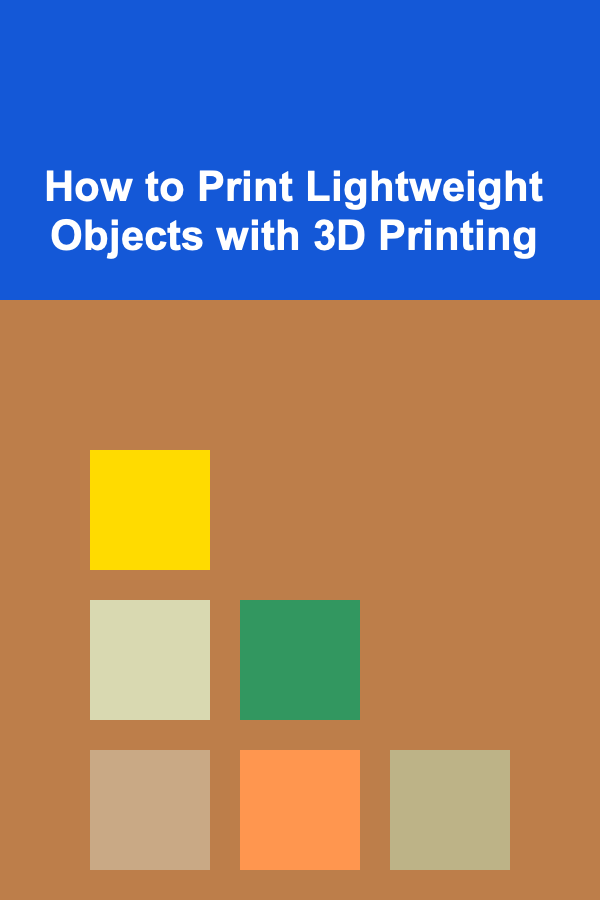
How to Print Lightweight Objects with 3D Printing
ebook include PDF & Audio bundle (Micro Guide)
$12.99$11.99
Limited Time Offer! Order within the next:

3D printing has revolutionized the manufacturing industry by enabling the creation of complex geometries, rapid prototyping, and the ability to produce highly customized products. One of the most significant advantages of 3D printing is its ability to produce lightweight objects that do not sacrifice strength or durability. This article will explore the principles behind printing lightweight objects using 3D printing technology, including material choices, design considerations, and advanced techniques.
Understanding Lightweight Objects in 3D Printing
In the context of 3D printing, a "lightweight object" refers to an object that has been designed to minimize its mass while maintaining the required strength, functionality, and durability. Lightweight designs are crucial in many industries such as aerospace, automotive, robotics, and medical applications where reducing weight is essential for performance, efficiency, and cost savings. 3D printing offers unique capabilities that allow for the creation of these objects, which cannot always be achieved using traditional manufacturing techniques.
Key Benefits of Lightweight 3D Printed Objects
- Reduced Material Use: Lightweight designs often require less material, which can significantly reduce costs and environmental impact.
- Improved Performance: Reducing weight, especially in industries like aerospace or automotive, can enhance fuel efficiency, speed, and maneuverability.
- Enhanced Durability: Lightweight structures can be designed to be strong and durable, making them suitable for harsh environments.
- Faster Prototyping: The ability to rapidly prototype lightweight designs allows for quicker iteration cycles and faster product development.
3D Printing Materials for Lightweight Objects
The choice of material plays a critical role in the weight and performance of the final object. Some materials are naturally lighter than others, while some can be reinforced or designed in such a way as to reduce their overall mass.
1. Plastic Materials
Plastic is the most commonly used material in 3D printing due to its affordability, versatility, and ease of use. Many types of plastic are available, each with different characteristics in terms of weight, strength, and flexibility.
- PLA (Polylactic Acid): PLA is one of the lightest and easiest-to-print materials. It is biodegradable and commonly used for prototypes and lightweight consumer products. While it's not the strongest material available, its lightness makes it suitable for many applications.
- ABS (Acrylonitrile Butadiene Styrene): ABS is a popular plastic for 3D printing due to its durability, resistance to impact, and ability to handle heat better than PLA. Although it's a little heavier than PLA, ABS still provides a good balance of lightweight and strength.
- PETG (Polyethylene Terephthalate Glycol): PETG is a slightly heavier material compared to PLA and ABS but is often used when transparency and durability are required. It is a great choice for objects that need to be lightweight but also resistant to stress and wear.
- Nylon: Known for its high strength and flexibility, nylon is a slightly heavier material. However, through optimized designs and the use of honeycomb or lattice structures, it can be used to create strong yet lightweight components.
2. Composite Materials
Composites are materials made by combining two or more different substances to enhance the properties of the base material. These materials offer a good balance of lightweight properties and strength, making them ideal for applications that require both lightness and durability.
- Carbon Fiber Reinforced Filament: This material is a composite of carbon fiber and a thermoplastic such as nylon or PLA. The carbon fibers help reinforce the material, making it both stronger and lighter. Carbon fiber-infused filaments are commonly used in industries like aerospace and automotive for lightweight yet robust components.
- Glass Fiber Reinforced Filament: Similar to carbon fiber, glass fiber composites are used to enhance the strength-to-weight ratio of printed objects. Glass fiber-reinforced filaments can provide excellent rigidity while keeping the object lightweight.
3. Metal Materials
Although metals are typically heavier than plastics, certain metal alloys can be used for lightweight yet strong designs. These alloys are often used in applications that require high performance, such as in the aerospace industry.
- Aluminum: Aluminum is widely used in 3D printing because of its lightweight nature and high strength-to-weight ratio. It is often used in the production of lightweight yet durable parts for aerospace, automotive, and even medical devices.
- Titanium: Titanium is another metal with an excellent strength-to-weight ratio. While it is heavier than aluminum, it is still much lighter than other metals like steel, making it an ideal choice for applications requiring high strength and low weight.
- Stainless Steel (for specialized applications): While stainless steel is heavier, it can still be used in some 3D printing applications where strength is more important than weight, especially when combined with advanced design strategies to reduce its mass.
Design Techniques for Lightweight Objects
Once the material is selected, the next step is to design the object for lightweight properties. 3D printing allows for highly customizable geometries that are difficult or impossible to achieve with traditional manufacturing methods. The following design techniques can help reduce the weight of an object while maintaining or even enhancing its strength and functionality.
1. Lattice Structures
One of the most effective ways to create lightweight objects is by utilizing lattice structures. Lattices are intricate internal geometries that reduce material usage while maintaining structural integrity. These structures are especially useful in aerospace and automotive industries, where parts need to be lightweight but strong enough to handle stresses and forces.
Lattice structures allow for the creation of parts that are much lighter than solid parts, as the voids within the lattice reduce the overall material volume. The key to successful lattice design is ensuring that the structure is optimized for strength in the required areas while minimizing unnecessary material in less critical regions.
2. Honeycomb Structures
Honeycomb patterns are another common design strategy for lightweight 3D printed objects. The hexagonal cells of a honeycomb structure provide strength and rigidity, while the design itself reduces the overall weight of the object. This design is particularly well-suited for parts that will experience compressive or shear forces.
Honeycomb structures are widely used in industries where both lightness and strength are crucial, such as aerospace, where they are used in the construction of airplane wings, engine parts, and other critical components.
3. Thin-Walled Designs
Thin-walled designs refer to objects with outer walls that are as thin as possible without compromising structural integrity. By reducing the thickness of the material used in non-load-bearing sections of the object, you can significantly reduce the weight while still maintaining strength where it is needed.
In 3D printing, thin-walled designs can be particularly advantageous because the printing process allows for the creation of these designs with a high degree of precision. However, careful consideration must be given to the part's structural requirements to avoid weakness in critical areas.
4. Topology Optimization
Topology optimization is a sophisticated computational design technique that allows for the creation of optimized geometries that minimize material use while meeting strength and performance requirements. This technique uses advanced algorithms to identify the best material distribution within a given space, ensuring the object is both lightweight and structurally sound.
Topology optimization is commonly used in industries like aerospace and automotive to create complex, highly efficient designs that would be impossible to create using traditional manufacturing methods. 3D printing is the ideal production method for these optimized designs, as it can create intricate geometries that traditional methods cannot.
5. Variable Density
Variable density refers to the practice of altering the internal density of an object based on the load and stress areas. High-stress areas of the object can have a higher material density, while low-stress areas can have a lower density or even be hollow. This technique allows for a part to be as light as possible without sacrificing performance.
Variable density is particularly useful in parts that require customized strength distribution, such as custom orthopedic implants, lightweight automotive components, or specialized drones.
Post-Processing and Finishing Lightweight 3D Printed Objects
After printing a lightweight object, post-processing is often necessary to improve the finish, durability, and overall quality of the object. Post-processing steps can include:
- Sanding and Polishing: To smooth out rough surfaces and improve the aesthetic of the printed object.
- Strengthening: Some lightweight designs may need additional reinforcement, such as through coating with resin or a metal spray to improve their durability.
- Heat Treatment: For certain materials like nylon or metal alloys, heat treatment may be applied to improve mechanical properties.
Conclusion
3D printing offers incredible opportunities for creating lightweight objects that meet the needs of various industries, including aerospace, automotive, and medical sectors. The combination of lightweight materials, advanced design techniques, and the unique capabilities of 3D printing makes it possible to create structures that are both strong and lightweight. By understanding the materials, design principles, and post-processing techniques, engineers and designers can unlock the full potential of 3D printing to produce high-performance, lightweight objects that are essential for the next generation of innovation.

How to Maintain Cybersecurity in a Virtual Workspace
Read More
Mastering Healthcare Consulting: Essential Strategies for the Modern Healthcare Consultant
Read More
Tethered Shooting: A Comprehensive Guide
Read More
Exploring the Truth Behind UFO Sightings and Alien Encounters
Read MoreHow to Build a Simple Auto Insurance Expense Tracker in Google Sheets
Read More
10 Tips for Understanding Your Lease Agreement
Read MoreOther Products

How to Maintain Cybersecurity in a Virtual Workspace
Read More
Mastering Healthcare Consulting: Essential Strategies for the Modern Healthcare Consultant
Read More
Tethered Shooting: A Comprehensive Guide
Read More
Exploring the Truth Behind UFO Sightings and Alien Encounters
Read MoreHow to Build a Simple Auto Insurance Expense Tracker in Google Sheets
Read More